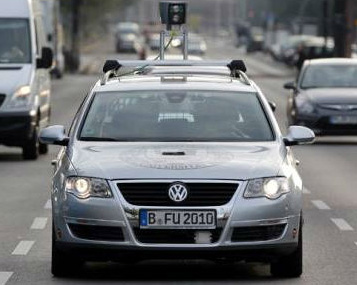The consensus among auto industry technologists, gathered in Detroit this week for SAE International World Congress, is that by the middle of this decade, cars that can largely pilot themselves through traffic jams will be offered for sale. By 2020, cars capable of taking over most of the work of high speed driving could debut, and by 2025, fully autonomous vehicles might hit the streets in meaningful numbers.
Those dates are still "guesstimates," said Christian Schumacher, head of advanced driver assistance systems in North America for German automotive technology giant Continental AG.
Still, auto makers -- and safety regulators in the U.S. and Europe -- say they're serious about pushing more autonomous braking and steering systems into cars and trucks, for one overriding reason: Most humans are depressingly bad drivers.
The National Highway Traffic Safety Administration, in a study of crash data harvested from black boxes installed in cars, found that just 1% of drivers involved in the collisions applied the brakes at full force before the collision. About 33% of the drivers in the crashes NHTSA analyzed didn't apply the brakes at all, NHTSA researcher W. Riley Garrott told attendees at a session Wednesday.
About 220 people were killed in the 910,000 rear-end crashes the agency analyzed to learn about driver braking behavior, he said. Crashes in which braking mistakes were a factor cost society $45 billion, based on a survey of 2006- 2008 data, Mr. Garrott said.
A separate study of driver behavior presented Wednedsay found that in a sample of crashes involving a car swerving out of the lane, 65% of the drivers were speeding, and 57% of drivers either sped up, or made no significant change in speed just prior to hitting a car, tree guard rail or roadside wall. (Note: An earlier version of the post had an incorrect figure for the share of drivers who sped up or made no significant change in speed.)
NHTSA officials have railed against people who text or otherwise fiddle with smartphones behind the wheel.
Jay Joseph, senior manager of product regulatory affairs for Honda Motor Co.'s U.S. operations, said his commute to work on Los Angeles' notoriously congested 405 freeway is a daily reminder of how disengaged most motorists are.
"The 405 is an incubator for bad driving habits," Mr. Joseph told SAE attendees.
But Mr. Joseph said smartphones are just a slice of the distraction problem. After all, traffic fatality rates have declined even as smartphone ownership in the U.S. has climbed to 87% of American adults.
"If you looked at the trends, you'd think, 'more mobile phones reduce crashes,' " Mr. Joseph said.
Mr. Joseph cited a recent study by Erie Insurance Group that found many drivers involved in a crash admitted they were "lost in thought" before the impact.
Since the advent of Henry Ford's Model T, auto makers have marketed the freedom, mastery and romance that comes from driving your own car. The industry is wary of moving too quickly to abandon that marketing strategy. Still, the plateauing of U.S. highway death rates -- and Google's high profile experiments with self-driving cars -- are spurring the automotive establishment to talk more openly about its own efforts to sideline human drivers in favor of digital chauffeurs.
Nissan Motor Corp., for example, says it's working on a system that will take control of the steering if the driver fails to respond to an object, such as a parked car or pedestrian, detected by forward-looking radar sensors.
Other auto makers, and technology suppliers such as Continental, are expanding the capability of so-called "active safety" systems already on board many new cars and trucks. These systems are built around sensors that can look ahead, to the side or even behind the car to detect obstacles.
Onboard computers can calculate whether the car they're in is closing too fast with the objects outside, and use the cruise control to slow the car down, or order up a warning signal to the driver, or if the driver still doesn't react, engage the brakes.
Luxury car makers -- and some mass market brands --are starting to present these driver assistance technologies as desirable safety upgrades. Marketing a car that can manage its own way through a 25 mile per hour rush hour crawl is a short step away.
What role federal regulators will play in forcing the industry's hand isn't clear. NHTSA's Mr. Garrott said the agency is stepping up its research on the effectiveness of forward crash warning systems, "crash imminent braking," dynamic brake support (which applies more braking power even if the driver doesn't), and systems that can automatically detect and avoid pedestrians.
Among other activities, NHTSA has developed a dummy car, made of carbon fiber and modeled after the back end of a 2011 Ford Fiesta, to give radars in crash avoidance systems something to look at. Pedestrians are represented in the agency's crash tests by a dummy in a Charlie Sheen mask.
"NHTSA intends to make a decision on these technologies by the end of 2013," Mr. Garrott told a packed conference room. What decision, he says, agency officials don't yet know. One big concern is assuring that crash avoidance technology is mature enough not to generate a lot of false warnings or interventions, for which drivers would have "zero acceptance, " he said.













 At the dawn of the automobile age, driving a car wasn't a high status activity. Not driving it was. And within a decade, the auto business could return full circle to the concept of motorists as mainly passengers.
At the dawn of the automobile age, driving a car wasn't a high status activity. Not driving it was. And within a decade, the auto business could return full circle to the concept of motorists as mainly passengers.